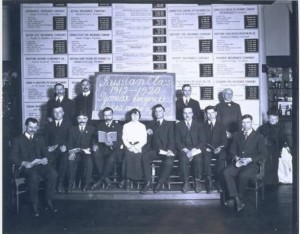Immigration to Connecticut in the early 20th century continued much as it had in decades prior. It was an era that witnessed large populations of southern and eastern European immigrants arrive to complement the primarily northern and western Europeans who came to the United States in the middle of the 19th century. In particular, Connecticut played host to new, vast populations of Italian, Polish, and French Canadian immigrants who helped reinvent the state’s cultural identity.
Italians (who began arriving in Connecticut in large numbers during the late 1800s) originally took unskilled positions as factory and construction workers—but as years passed, they increasingly found work as barbers, tailors, and musicians in the state’s major cities like Hartford and New Haven. Italians were the largest immigrant group to arrive on Connecticut shores in the early stages of the 20th century, increasing their numbers from approximately 20,000 in 1900 to over 227,000 by 1930.
Polish and French Canadian Arrivals
The 1905 Revolution in eastern Europe sparked the arrival of thousands of Polish immigrants primarily to the counties of Middlesex, New London, Tolland, and Hartford. While some Poles took jobs in the textile or brass mills, many earned their living as farmers. The massive influx of Polish immigrants in the early 20th century gave Connecticut the highest Polish population of any state in New England.
Large numbers of French Canadians also arrived during this period and found abundant opportunities in the state’s textile mills. While French Canadian populations in Connecticut were less numerous than in other New England states, they still made significant contributions to the state’s cultural development, particularly in the heavily populated areas of Hartford.
The generations of immigrants who arrived in prior decades continued to pave the way for these new arrivals to find homes and jobs in Connecticut. The kinship and friendship networks that developed over the years meant that more than 4 out of every 5 immigrants arriving in the state found lodging with friends or relatives.
The concentration of immigrants in Connecticut, as well as in the entire Northeast, came largely from a rise in industry that brought about the urbanization of local populations. By 1920, 51% of the total population of the United States lived in urban areas. This number reached 75% for foreign-born residents and over 84% for foreign-born Poles and Italians.
Connecticut proved a particularly attractive draw for newly arriving immigrants because of its expanding manufacturing base. Many young immigrants sought factory work and the state’s prosperous industries afforded them abundant opportunities for employment.
Many of the women who came to Connecticut from other parts of the world in the early decades of the 20th century found work as domestics for wealthy industrial entrepreneurs. In addition, about 40% of these women tended boarders in rooming houses, washed clothes, or found piece work. When home-based work dropped off significantly in the 1930s, women often joined men in the factories.
World War I and Great Depression Breed Anti-Immigrant Sentiments
By the start of World War I, immigration had radically reshaped Connecticut’s cultural landscape. Where American-born residents made up 75% of Connecticut’s population in 1870, that figure dropped to only 35% by the First World War. At that time, Connecticut maintained one of the largest proportions of foreign-born residents found in any state—ranking third after Massachusetts and Rhode Island.

Jack Delano, Mr. and Mrs. Andrew Lyman, Polish tobacco farmers near Windsor Locks, Connecticut – Office of War Information, Library of Congress, Prints and Photographs Division
By the end of the World War I, however, the great wave of recent immigration slowly began to dry up. The economic turmoil and “Red Scare” that came in the wake of peace in Europe turned popular sentiment against liberal immigration policies. The entire nation soon found itself caught up in a groundswell of nativism. This brought about the expansion of several anti-immigrant (as well as anti-Jewish and anti-Catholic) groups in Connecticut, including the Klu Klux Klan.
The Great Depression only exacerbated these tensions as competition for jobs brought about increasing resentment of new immigrants. In 1930, Connecticut was not only home to large populations of Italians, Irish, Poles, and French Canadians, but also hundreds of thousands of Czechoslovakians, Lithuanians, Russians, Germans, and other immigrants who all competed for increasingly scarce jobs. Particularly hard hit were the manufacturing jobs found in major cities that many immigrants relied upon for their livelihood. The fear and resentment many citizens felt toward the country’s new arrivals resulted in the US government passing increasingly restrictive immigration laws that ensured it would be several more decades before Connecticut witnessed another concentrated influx of foreign-born residents.










